#not a fan of how he cast other religions' deities as Actual Demons trying to damn people to hell obvi.
Explore tagged Tumblr posts
Text
thank god i have realized that i can Post On Tumblr (make insane little personal posts whenever i want) since the last time i picked up paradise lost. the girlies in the gc were not very receptive to my screaming over milton's descriptions of satan and of hell but i know in my heart that the tumblrinas will come through for me
#esp since i got like 150 new followers from a quiz going crazy ab saints 😭#i have gathered the target audience! the target audience is here!#'oh you need to know the political and historical context to fully understand paradise lost' (- my mother)#false. i can enjoy it as a work of literary fiction and a way to process my religious issues#BECAUSE. GOD. MILTON POPPED OFF.#not a fan of how he cast other religions' deities as Actual Demons trying to damn people to hell obvi.#but we can have Fuck Catholicism dissertations as their own post :)#do protestants believe in satan? hold on#yeah. yeah okay.#i get distrustful of what i assume to be commonalities between catholicism and protestantism </3#no saints over there. no communion no transubstantiation. like at this rate what Do y'all have#valentine notes#paradise lost readthrough
32 notes
·
View notes
Text
Retconned Names for “The Loa” (Hazbin Hotel)
I’ve decided to retcon the names of my DeviantArt OCs. These are their new names:
Papa Legba (Papa Lébat) → Big Papa / The Doorkeeper
Damballah → Sir Duke / Grandfather Serpent
Baron Samedi → Baron de la Mort (The Baron)
Maman Brigitte → Maman de la Vie (Grann Manman)
Erzulie Dantor → Lady Love
Ogun (Ogou Feray) → Ironman
Erzulie Freda → Lady Rose
("The Baron of Death" and "Maman la Vie" are Scrapped Concepts. They are now demons named "Lanmò" and "Lavi")
They mostly have song-themed names now.
JoJo’s Bizarre Adventure!!!
To signify their importance to 19th century New Orleans Vodou, the characters inspired by Papa Legba and Damballah each have two names. Sir Duke is also called Grandfather Serpent, as a reference to “Grandfather Rattlesnake”, who probably has a common origin with Damballah.
For now, I am still calling them “The Loa”, but I’m fine with changing this to “lesser gods” if that’s offensive. It’s pretty obvious who inspired the lesser gods!
I rant about the rationale behind this decision below the cut:
After thinking about this seriously, I think it is irresponsible to name these characters after the actual deities.
I’ve grappled with this dilemma, since this really does break the naming convention of this show. If the St. Peter-type character is still named “St. Peter”, why should an exception be made? Because Vodou isn’t like Christianity. Christianity is the majority religion in America, and many other places in the world; Vodou is a minority religion that has this horrible history of demonization and mischaracterization. This goes all the way back to the 1800s (and earlier!), and has continued into the present day, with pieces of popular media like The Princess and the Frog and American Horror Story.
Whenever they appear in popular media, the lwa (or, characters named after them) are usually designed / written by people outside the Vodou community. As a consequence of this, outsiders have spread misinformation about Vodou and damaged the reputation of the community. Fans of Hazbin Hotel understand that these characters aren’t actually the deities they’re named after. But this context is not readily apparent to those outside of this fandom. If you don’t change their names, people will think that this show is trying to present commentary on the actual deities. Criticisms of cultural appropriation would be warranted.
We have to consider the popularity of a show like Hazbin Hotel, and the effects this has. If you search “St. Peter”, you’re not going to find “St. Peter (Hazbin Hotel)” in the top results. Again, Christianity is the majority religion in America. But if they existed in the cast, it is likely that images of “The Loa (Hazbin Hotel)” would pop up when someone searches for [insert name of actual lwa].
And this isn’t just any fandom... Let’s be real here. The Hazbin Hotel fandom is just full of horny little bitches (CAN”T RELATE!!!!). THE GOD OF WAR MASCULINITY AND BLACKSMITHING has no shot at ever appearing in the canon of Hazbin Hotel. But if he ever did, and his character design was actually good, there would be a shitton of bara porn of him…!
DUDE!!!!!! WHAT”S THE OPPOSITE OF A JIMMY NEUTRON BRAIN BLAST MOMENT????
IMAGINE someone going online, just trying to find information about how to pray to / perform a sacrifice for the lwa, and yeah. A bunch of Hazbin Hotel hen ties and hot ass yaois pop up!!!
STOP LAUGHING!!!
In all seriousness, it’s legitimately awful!
This is why I think it’s just irresponsible to name them after the actual deities. It’s just really disrespectful to the people who worship them!
On top of this, let’s consider Papa Legba specifically. Here, my “Papa Legba”-type character is clearly this weird Steven’s Universe fusion of Papa Legba and Dahomean Legba. I actually think it is completely warranted to pay tribute to Dahomean Legba, as he is the spiritual father of all jazz and blues musicians.
It’s a show about singing and history!!!!!
But this is how Papa Legba is portrayed in New Orleans Voodoo:
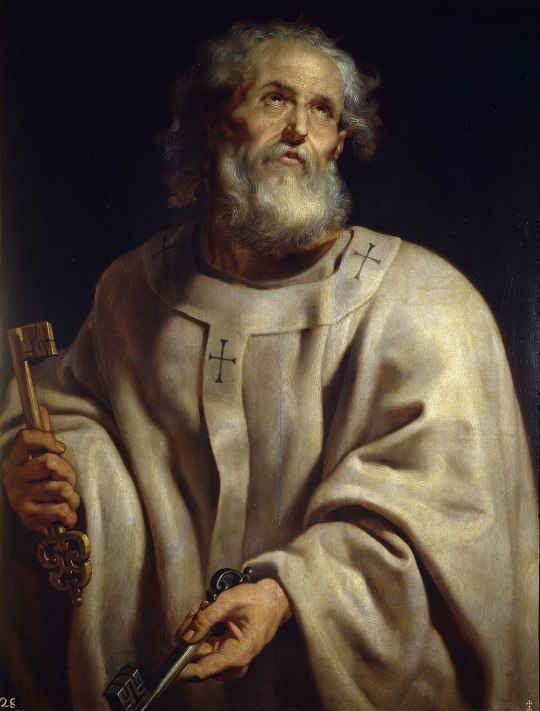
Look at how he’s portrayed in art from the Vodou Renaissance!
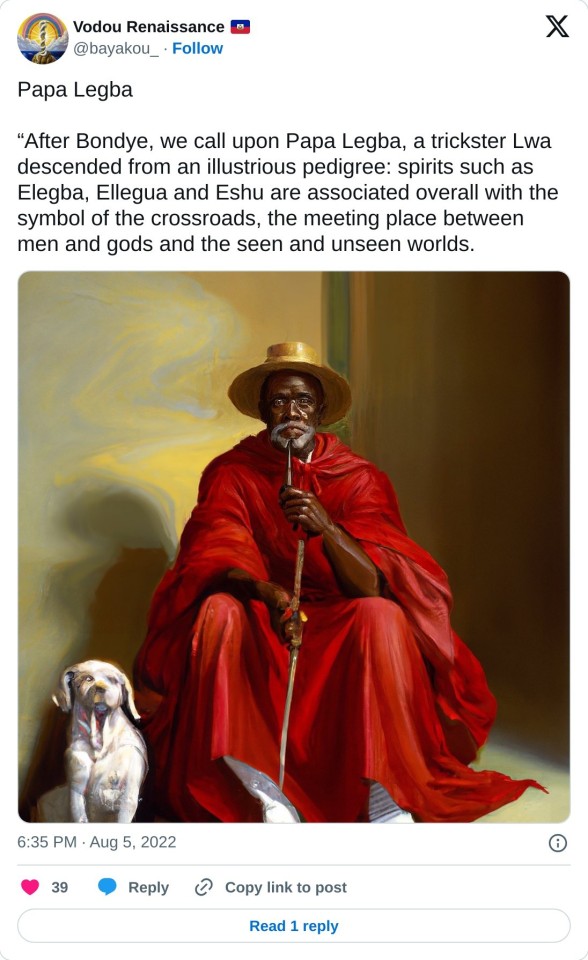
Not only has he been widely misrepresented in popular media! He is arguably the single most important lwa from New Orlean Vodou, especially to someone like Alastor who was born at the end of the 19th century!
It must be COMPLETELY sacrilegious to equate Papa Legba with Dahomean Legba!!!
I love him so much….but if you’ve seen what Dahomean Legba looks like…you know what I’m talking about… (THERE”S A REASOIN HE”S LIKE THIS, OK???!!!!)
It is not AT ALL my intent to equate those two deities, but if this character is named “Papa Legba”, that intent is not readily apparent!
I’m also afraid that I made “Big Papa” look too goofy. THIS IS GOING TO BLOW YOUR MIND but not everyone reads One Piece. It pains me to say this…b-but even Edwar D. Newgate looks a lil fuckin stupid to people who don’t read One Piece…!
To people who don’t read One Piece, this really could be read as “Holy shit!! You’re trying to make Papa Legba – arguably single most important lwa from New Orleans Vodou – look like a goofy fucking idiot!”
NO!!!!! I”M TRYING TO MAKE HIM LOOK LIKE MONKEY D. GARP BECAUSE I LOVE MONKEY D. GARP!!!!!!
…But yeah. This is why I decided to just change his name. He’s just called “Big Papa” now. I’m also going to try to tone down the goofiness a bit more. I’m really not trying to make him look like a goofy fucking idiot. My intent is to give him range, where he can be playful but also dignified and imposing when the situation calls for it. I actually want him to be a cool character!
Anyways, here’s trivia regarding the new names:
For the most part, they have song-themed names. “Big Papa” is derived from The Notorious B.I.G.’s “Big Poppa”. “Sir Duke” is derived from Stevie Wonder’s “Sir Duke”. “Lady Love” is derived from Lou Rawls’ “Lady Love”. “Lady Rose” is derived from Louis Armstrong’s “La Vie En Rose”. The two Erzulie-type characters are both “Lady–” something, and their names are references to love songs because they are goddesses of love.
Originally, I was going to call the Ogou Feray-type character GOD WARRIOR because I love Marguerite D. Perrin, but that’s a stupid fucking name, and you can’t give who is arguably the single most important lwa a stupid fucking name! He is now named “Ironman” as a reference to Black Sabbath’s “Iron Man”. I don’t know if Tony D. Stark would let you get away with this…but this is what he’s named in my fanfiction.
When I have time, I do plan to go back and fix up the tags and issue a notice on my AO3 account. It just might take me a while to get around to this.
OTHER CONSIDERATIONS FOR THE PORTRAYAL OF VODOU
Because I am FULLY INSANE, I love to think to myself “What if the boys were actually in the canon of Hazbin Hotel?”
OBVIOUSLY no NSFW merch should be sold of them. As far as merch is concerned, they should be treated like St. Peter (Hazbin Hotel). If any merch of them was sold, the profits should be donated to the New Orleans Vodou community. Not the commercialized side of it, that’s full of white people who are bastardizing Vodou. The ACTUAL keepers of the tradition, who are going to be of African descent. The thought THE LWA getting turned into commercialized products is just horrible to me… Donating all profits to the people who should actually receive it would really make the world a better place!
I share these thoughts, but ultimately it really doesn’t matter AT ALL what I think should be done. What actually matters is the opinion of people in the New Orleans Voodoo community. If the approach is not to retcon Alastor and to add more Voodoo-related elements to the show, surely the creative team behind Hazbin Hotel should hire consultants with expertise and connections to this community.
For example, I imagine my depiction of The Baron of Death is controversial. I REALLY tried not to emasculate him, but I think his depiction could be read the wrong way. There is a side of Vodou that is accepting of the LGBTQ community; there is another side that is very much not accepting of it. The consultant should have the final say on whether it’s OK to make one of these characters an actual trans headcanon. If the consultant is like “this is really uncomfortable and disrespectful”, then this should go on the cutting room floor. As I’ve touched on before, even LGBTQ communities have a problem with misrepresenting minority cultures. It is more important to portray this culture accurately, and their deities respectfully. There are other creative ways to work in LGBTQ (specifically, trans) rep into the show!
Another example: The inclusion of Ironman. I’m so CRAZY for even thinking about this… Kratos (God of War) has no shot at popping into Precure! But yeah. I would not want to exclude him due to his chief importance, but it is in fact inevitable that the horny ass bitches (like myself…) in this fandom will draw bara of THE BLACKSMITHING WARRIOR GOD OF MASCULINITY. If the consultant is like “don’t include him” for this reason, then just don’t include him.
Thanks for coming to my TEDx Talk!
#the loa (hazbin hotel)#big papa legba#damballah (hazbin hotel)#baron samedi (hazbin hotel)#maman brigitte (hazbin hotel)#erzulie dantor (hazbin hotel)#erzulie freda (hazbin hotel)#ogun (hazbin hotel)#commentary#big papa (hazbin hotel)#sir duke (hazbin hotel)#the baron of death (hazbin hotel)#maman la vie (hazbin hotel)#lady love (hazbin hotel)#lady rose (hazbin hotel)#ironman (hazbin hotel)#baron de la mort (hazbin hotel)#maman de la vie (hazbin hotel)
6 notes
·
View notes
Text
The Two (or more) Ishtars or A Certain Scandalous Easter Claim Proved to be The Worship of Reverend Alexander Hislop

Once upon a time the official facebook page of Richard Dawkins' foundation posted a graphic according to which the holiday of Easter is just a rebranded celebration of the Mesopotamian mythology superstar Ishtar, arguing that the evidence is contained in its very name. As everyone knows, Dawkins is an online talking head notable for discussing his non-belief in such an euphoric way that it might turn off even the most staunch secularists and for appearing in some reasonably funny memes about half a decade ago. Bizarrely enough, however, the same claim can be often found among the crowds dedicated to crystal healing, Robert Graves' mythology fanfiction, indigo children and similar dubiously esoteric content. What's yet more surprising is that once in a while it shows up among a certain subset of fundamentalist Christians, chiefly the types who believe giants are real (and, of course, satanic), the world is ruled by a secret group of Moloch worshipers and fossils were planted by the devil to led the sheeple astray from the truth about earth being 6000 years old, tops. Of course, to anyone even just vaguely familiar with Christianity whose primary language isn't English this claim rightfully seems completely baffling – after all it's evident in most languages that the name of the holiday celebrating Jesus' resurrection, and many associated customs, are derived from the earlier Jewish Pascha (Passover) which has nothing to do with Ishtar other than having its origin in the Middle East. Why would the purported association only be evident in English and not in Aramaic, Greek, Latin, Spanish, virtually any language other than English and its close relatives – languages which generally didn't have anything to do with Mesopotamia or early christianity? Read on to find out what sort of sources let this eclectic selection of characters arrive to the same baffling conclusion, why are they hilariously wrong, and – most importantly – where you can actually find a variety of Ishtars (or at least reasonably Ishtar-like figures) under different names instead.
The story of baffling Easter claims begins in Scotland in the 19th century. A core activity of theologians in many faiths through history was (and sometimes still is) finding alleged proof of purported “idolatry” or other “impure” practices among ideological opponents, even these from within the same religion – and a certain Presbyterian minister, Alexander Hislop, was no stranger to this traditional pastime. Like many Protestants in this period, he had an axe to grind with the catholic church - though not for the reasons many people are not particularly fond of this institution nowadays. What Hislop wanted to prove was much more esoteric – he believed that it's the Babylon known from the Book of Revelations. Complete with the beast with seven heads, blasphemous names and other such paraphernalia, of course. This wasn't a new claim – catholicism was equated with the New Testament Babylon for as long as Protestantism was a thing (and earlier catholicism itself regarded other religions as representing it). What set Hislop apart from dozens of other similar attempts like that was that he fancied himself a scholar of history and relied on the brand new accounts of excavations in what was once the core sphere of influence of the Assyrian empire (present day Iraq and Syria), supplemented by various Greek and Roman classics – though also by his own ideas, generally varying from baseless to completely unhinged. Hislop compiled his claims in the book The Two Babylons or The Papal Worship Proved to be the Worship of Nimrod and His Wife. You can find it on archive.org if you want to torment yourself and read the entire thing – please do not give clicks directly to any fundie sites hosting it though. How does the history of Easter and Ishtar look like according to Hislop? Everything started with Semiramis, who according to his vision was a historical figure and a contemporary of Noah's sons, here also entirely historical. Semiramis is either entirely fictional or a distorted Greek and Roman account of the 9th century BC Assyrian queen Shammuramat, who ruled as a regent for a few years after the death of her husband Shamshi Adad V – an interesting piece of historical trivia, but arguably not really a historical milestone, and by the standards of Mesopotamian history she's hardly a truly ancient figure. Hislop didn't even rely on the primary sources dealing with the legend of Semiramis though, but with their medieval christian interpretations, which cast her in the role of an adulterer first and foremost due to association of ancient Mesopotamia with any and all vices.
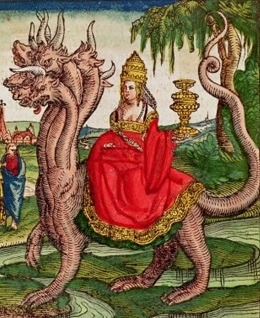
Hislop claims that Semiramis was both the Whore of Babylon from the Book of Revelations and the first idolater, instituting worship of herself as a goddess. This goddess, he argues, was Astarte (a combination of two flimsy claims – Roman claim that Semiramis' name means “dove” and now generally distrusted assumption that Phoenician Astarte had the same symbols as Greek Aphrodite) and thus Ishtar, but he also denotes her as a mother goddess – which goes against everything modern research has to say about Ishtar, of course. However, shoddy scholarship relying on few sources was the norm at the time, and Hislop on top of that was driven by religious zeal. In further passages, he identified this “universal mother” with Phrygian Cybele, Greek Rhea and Athena, Egyptian Isis, Taoist Xi Wangmu (sic) and many more, pretty much at random, arguing all of them were aspects of nefarious Semiramis cult which infected all corners of the globe. He believed that she was venerated alongside a son-consort, derived from Semiramis' even more fictional husband Ninus (a mythical founder of Assyria according to Greek authors, absent from any Mesopotamian sources; his name was derived from Nineveh, not from any word for son like Hislop claims), who he identifies with biblical Nimrod (likewise not a historical figure, probably a distorted reflection of the god Ninurta). Note the similarity with certain ideas perpetrated by Frazer's Golden Bough and his later fans like Jung, Graves and many neopagan authors – pseudohistory, regardless of ideological background, has a very small canon of genuinely original claims. Ishtar was finally introduced to Britain by “druids” (note once again the similarity to the baffling integration of random Greek, Egyptian or Mesopotamian deities into Graves-derived systems of fraudulent trivia about “universal mother goddesses” often using an inaccurate version of Celtic myths as framework). This eventually lead to the creation of the holiday of Easter. Pascha doesn't come up in the book at all, as far as I can tell. All of this is basically just buildup for the book's core shocking reveal: catholic veneration of Mary and depictions of Mary with infant Jesus in particular are actually the worship of Semiramis and her son-consort Ninus, and only the truly faithful can reveal this evil purpose of religious art. At least so claims Hislop. This bizarre idea is laughable, but it remains disturbingly persistent – do you remember the Chick Tracts memes from a few years ago, for example? These comics were in part inspired by Hislop's work. Many fundamentalist christian communities appear to hold his confabulations in high esteem up to this day – and many people who by design see themselves as a countercultural opposition to christianity independently gleefully embrace them, seemingly ignorant of their origin. While there are many articles debunking Hislop's claim about Easter, few of them try to show how truly incomprehensibly bad his book is as a whole – hopefully the following examples will be sufficient to illustrate this point: -Zoroaster is connected to Moloch because of the Zoroastrian holy fire - and Moloch is, of course Ninus. Note that while a few Greek authors believed Zoroaster to be the “king of Bactria” mythical accounts presented as a contemporary of Ninus, the two were regarded as enemies – Hislop doesn't even follow the pseudohistory he uses as proof! -Zoroaster is also Tammuz. Tammuz is, of course, yet another aspect of Ninus. -demonic character is ascribed to relics of the historical Buddha; also he's Osiris. And Ninus. -an incredibly racist passage explains why the biblical Nimrod (identified with – you guessed it - Ninus) might be regarded as “ugly and deformed” like Haephestus and thus identical to him (no, it makes no sense in context either) - Hislop thinks he was black (that's not the word he uses, naturally) which to him is the same thing. -Attis is a deification of sin itself -the pope represents Dagon (incorrectly interpreted as a fish god in the 19th century) -Baal and Bel are two unrelated words – this is meant to justify the historicity of the Tower of Babel by asserting it was built by Ninus, who was identical to Bel (in reality a title of Marduk); Bel, according to Hislop, means “the confounder (of languages)” rather than “lord” -the term “cannibal” comes from a made up term for priests of Baal (Ninus) who according to Hislop ate children. In reality it's a Spanish corruption of the endonym of one of the first tribes encountered by the Spanish conquerors in America, and was not a word used in antiquity – also, as I discussed in my Baal post, the worship of Baal did not involve cannibalism. This specific claim of Hislop's is popular with the adherents of prophetic doomsday cult slash wannabe terrorist group QAnon today, and shows up on their “redpilling” graphics. -Ninus was also Cronos; Cronos' name therefore meant “horned one” in reference to Mesopotamian bull/horned crown iconography and many superficially similar gods from all over the world were the same as him - note the similarity to Margaret Murray's obsession with her made up idea of worldwide worship of a “horned god” (later incorporated into Wicca). -Phaeton, Orpheus and Aesculapius are the same figure and analogous to Lucifer (and in turn to Ninus) -giants are real and they're satanists (or were, I think Hislop argues they're dead already). They are (were?) also servants of Ninus. -as an all around charming individual Hislop made sure to include a plethora of comments decrying the practices of various groups at random as digressions while presenting his ridiculous theories – so, while learning about the forbidden history of Easter, one can also learn why the author thinks Yezidi are satanists, for example -last but not least, the very sign of the cross is not truly christian but constitutes the worship of Tammuz, aka Ninus (slowly losing track of how many figures were regarded as one and the same as him by Hislop). Based on the summary above it's safe to say that Hislop's claim is incorrect – and, arguably, malevolent (and as such deserves scrutiny, not further possibilities for spreading). However, this doesn't answer the question where does the name of Easter actually come from? As I noted in the beginning, in English (and also German) it's a bit of an oddity – it actually was derived from a preexisting pagan term, at least if we are to believe the word of the monk Bede, who in the 8th century wrote that the term is a derivative of “Eosturmonath,” eg. “month of Eostre” - according to him a goddess. There are no known inscriptions mentioning such a goddess from the British Isles or beyond, though researchers involved in reconstructing proto-indo-european language assume that “Eostre” would logically be a derivative of the same term as the name of the Greek Eos and of the vedic Ushas, and the Austriahenae goddesses from Roman inscriptions from present day Germany – eg. a word simply referring to dawn, and by extension to a goddess embodying it. This is a sound, well researched theory, so while early medieval chroniclers sometimes cannot be trusted, I see no reason to doubt Bede's account.
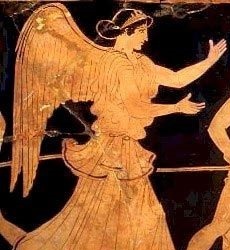
While Ushas is a prominent goddess in the Vedas, Eos was rather marginal in Greek religion (see her Theoi entry for details), and it's hard to tell to what degree Bede's Eostre was similar to either of them beyond plausibly being a personification of dawn. Of course, the hypothetical proto-indo-european dawn goddess all of these could be derived from would have next to nothing to do with Ishtar. While the history of the name of Easter (though not the celebration itself) is undeniably interesting, I suppose it lacks the elements which make the fake Ishtar claim a viral hit – the connection is indirect, and an equivalent of the Greek Eos isn't exactly exciting (Eos herself is, let be honest, remembered at best as an obscure part of the Odyssey), while Ishtar is understood by many as “wicked” sex goddess (a simplification, to put it very lightly) which adds a scandalous, sacrilegious dimension to the baffling lie, explaining its appeal to Dawkins' fans, arguably. As demonstrated above, Hislop's theories are false and adapting them for any new context – be it christian, atheist or neopagan – won't change that, but are there any genuine examples of, well, “hidden Ishtars”? If that's the part of the summary which caught your attention, rejoice – there is a plenty of these to be found in Bronze Age texts. I'd go as far as saying that most of ancient middle eastern cultures from that era felt compelled to include an Ishtar ersatz in their pantheons. Due to the popularity of the original Ishtar, she was almost a class of figures rather than a single figure – a situation almost comparable to modern franchising, when you think about it. The following figures can be undeniably regarded as “Ishtar-like” in some capacity or even as outright analogs:
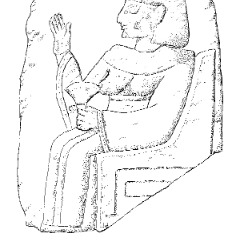
Astarte (or Ashtart, to go with a more accurate transcription of the oldest recorded version of the name) – the most direct counterpart of Ishtar there is: a cognate of her own name. Simply, put Astarte is the “Levantine”equivalent of the “Mesopotamian” Ishtar. In the city of Mari, the names were pretty much used interchangeably, and some god lists equate them, though Astarte had a fair share of distinct traits. In Ugaritic mythology, which forms the core of our understanding of the western Semitic deities, she was a warrior and hunter (though it's possible that in addition to conventional weapons she was also skilled at wielding curses), and was usually grouped with Anat. Both of them were regarded as the allies of Baal, and assist him against his enemies in various myth. They also were envisioned to spend a lot of time together – one ritual calls them upon as a pair from distant lands where they're hunting together, while a fragmentary myth depicts both of them arriving in the household of the head god El and taking pity on Yarikh, the moon god, seemingly treated as a pariah. Astarte's close relation to Baal is illustrated by her epithet, “face of Baal” or “of the name of Baal.” They were often regarde as a couple and even late, Hellenic sources preserve a traditional belief that Astarte and “Adados” (Baal) ruled together as a pair. In some documents from Ugarit concerned with what we would call foreign policy today they were invoked together as the most prominent deities. It's therefore possible that she had some role related to human politics. She was regarded as exceptionally beautiful and some texts favorably describe mortal women's appearance by comparing them to Astarte. In later times she was regarded as a goddess of love, but it's unclear if that was a significant aspect of her in the Bronze Age. It's equally unclear if she shared Ishtar's astral character – in Canaan there were seemingly entirely separate dawn and dusk deities. Despite clamis you might see online, Astarte was not the same as the mother goddess Asherah. In the Baal cycle they actually belong to the opposing camps. Additionally, the names are only superficially similar (one starts with an aleph, the other with an ayin) and have different etymology. Also, that famous sculpture of a very blatantly Minoan potnia theron? Ugaritic in origin but not a depiction of either Astarte or Asherah.
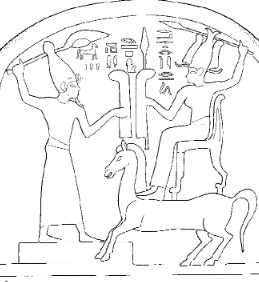
The Egyptians, due to extensive contact with Canaan and various Syrian states in the second half of the Bronze Age, adapted Astarte (and by extension Anat) into their own pantheon. Like in Ugarit, her warrior character was emphasized. An Egyptian innovation was depicting her as a cavalry goddess of sorts – associated with mounted combat and chariots. In Egypt, Ptah, the head god of Memphis and divine craftsman, was regarded as her father. In most texts, Astarte is part of Seth's inner circle of associates – however, in this context Seth wasn't the slayer of Osiris, but a heroic storm god similar to Baal. The so-called Astarte papyrus presents an account of a myth eerily similar to the Ugaritic battle between Baal and Yam – starring Seth as the hero, with Astarte in a supporting role resembling that played by Shaushka, another Ishtar analog, in the Hittite song of Hedammu, which will be discussed below.
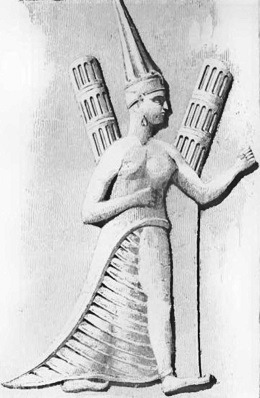
Shaushka – a Hurrian and Hittite goddess whose name means “the magnificent one” in the Hurrian language. Hurrian was widely spoken in ancient Mesopotamia and Anatolia (and in northernmost parts of the Levant – up to one fifth of personal names from Ugaritic documents were Hurrian iirc), but has no descendants today and its relation to any extant languages is uncertain. In Hittite texts she was often referred to with an “akkadogram” denoting Ishtar's name (or its Sumerian equivalent) instead of a phonetic spelling of her own (there was an analogous practice regarding the sun gods), while in Egyptian and Syrian texts there are a few references to “Ishtar Hurri” - “Ishtar of the Hurrians” - who is argued by researchers to be one and the same as Shaushka. Despite Shaushka's Hurrian name and her prominence in myths popular both among Hittites and Hurrians, her main cult center was the Assyrian city of Nineveh, associated with Ishtar herself as well, and there were relatively few temples dedicated to her in the core Hittite sphere of influence in Anatolia. Curiously, both the oldest reference to Shaushka and to the city of Nineveh come from the same text, stating that a sheep was sacrificed to her there. While most of her roles overlap with Ishtar's (she too was associated with sex, warfare and fertility), here are two distinct features of Shaushka that set her apart as unique: one is the fact she was perceived in part as a masculine deity, despite being consistently described as a woman – in the famous Yazılıkaya reliefs she appears twice, both among gods and goddesses. In Alalakh she was depicted in outfits combining elements of male and female clothing. Similar fashion preferences were at times attributed to Ninshubur, the attendant of Ishtar's Sumerian forerunner Inanna – though in that case they were likely the result of conflation of Ninshubur with the male messenger deity Papsukkal, while in the case of Shaushka the dual nature seems to be inherent to her (I haven't seen any in depth study of this matter yet, sadly, so I can't really tell confidently which modern term in my opinion describes Shaushka's character the best). Her two attendants, musician goddesses Ninatta and Kulitta, do not share it. Shaushka's other unique niche is her role in exorcisms and incantations, and by extension with curing various diseases – this role outlived her cult itself, as late Assyrian inscriptions still associated the “Ishtar of Nineveh” (at times viewed as separate from the regular Ishtar) with healing. It can be argued that even her sexual aspect was connected to healing, as she was invoked to cure impotence. The most significant myth in which she appears is the cycle dedicated to documenting the storm god's (Teshub for the Hurrians, Tarhunna for the Hittites) rise to power. Shaushka is depicted as his sister and arguably most reliable ally, and plays a prominent role in two sections in particular – the Song of Hedammu and the Song of Ullikummi. In the former, she seemingly comes up with an elaborate plan to defeat a new enemy of her brother - the sea monster Hedammu - by performing a seductive dance and song montage (with her attendants as a support act) and offering an elixir to him. The exact result is uncertain, but Hedammu evidently ends up vanquished. In the latter, she attempts to use the same gambit against yet another new foe, the “diorite man” Ullikummi – however, since he is unfeeling like a rock, she fails; some translators see this passage as comedic. However, elsewhere in the Song, the storm god's main enemy Kumarbi and his minions view Shaushka as a formidable warrior, and in the early installment of the cycle, Song of LAMMA, she seemingly partakes in a fight. In another myth, known only from a few fragments and compared to the Sumerian text “Inanna and the huluppu tree,” Shaushka takes care of “Ḫašarri” - a personification of olive oil, or a sentient olive tree. It seems that she has to protect this bizarre entity from various threats. While Shaushka lived on in Mesopotamia as “Ishtar of Nineveh,” this was far from the only “variant”of Ishtar in her homeland.
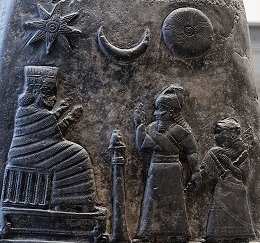
Nanaya was another such goddess. A few Sumerian hymns mention her alongside Inanna, the Sumerian equivalent of Ishtar, by the time of Sargon of Akkad virtually impossible to separate from her. As one composition puts it, Nanaya was “properly educated by holy Inana” and “counselled by holy Inana.” Initially she was most likely a part of Inanna's circle of deities in her cult center, Uruk, though due to shared character they eventually blurred together to a large degree. Just like Inanna/Ishtar, Nanaya was a goddess of love, described as beautiful and romantically and sexually active, and she too had an astral character. She was even celebrated during the same holidays as Inanna. Some researchers go as far as suggest Nanaya was only ever Inanna/Ishtar in her astral aspect alone and not a separate goddess. However, there is also evidence of her, Inanna and the sky god An being regarded as a trinity of distinct tutelary deities in Uruk. Additionally, king Melishipak's kudurru shown above shows both Nanaya (seated) and Ishtar/Inanna (as a star). Something peculiar to Nanaya was her later association with the scribe god Nabu. Sometimes Nabu's consort was the the goddess Tashmetu instead, but I can't find any summary explaining potential differences between them – it seems just like Nanaya, she was a goddess of love, including its physical aspects. Regardless of the name used to describe Nabu's wife, she was regarded as a sage and scribe like him – this arguably gives her a distinct identity she lacked in her early role as part of Inanna's circle. As the above examples demonstrate, the popularity of the “Ishtar type” was exceptional in the Bronze Age – but is it odd from a modern perspective? The myths dedicated to her are still quite fun to read today – much like any hero of ancient imagination she has a plethora of adversaries, a complex love life (not to mention many figures not intended to be read as her lovers originally but described in such terms that it's easy to see them this way today – including other women), a penchant for reckless behavior – and most importantly a consistent, easy to summarize character. She shouldn't be a part of modern mass consciousness only because of false 19th century claims detached from her actual character (both these from Hislop's works and “secular”claims about her purported “real”character based on flimsy reasoning and shoddy sources) – isn't a female character who is allowed to act about the same way as male mythical figures do without being condemned for it pretty much what many modern mythology retellings try to create? Further reading: On Astarte: -entry in the Iconography of Deities and Demons in Ancient Near East database by Izak Cornelius -‛Athtart in Late Bronze Age Syrian Texts by Mark S. Smith -ʿAthtartu’s Incantations and the Use of Divine Names as Weapons by Theodore J. Lewis -The Other Version of the Story of the Storm-god’s Combat with the Sea in the Light of Egyptian, Ugaritic, and Hurro-Hittite Texts by Noga Ayali-Darshan -for a summary of evidence that Astarte has nothing to do with Asherah see A Reassessment of Asherah With Further Considerations of the Goddess by Steve A. Wiggins On Shaushka: -Adapting Mesopotamian Myth in Hurro-Hittite Rituals at Hattuša: IŠTAR, the Underworld, and the Legendary Kings by Mary R. Bacharova -Ishtar seduces the Sea-serpent. A new join in the epic of Ḫedammu (KUB 36, 56 + 95) and its meaning for the battle between Baal and Yam in Ugaritic tradition by Meindert Dijkstra -Ištar of Nineveh Reconsidered by Gary Beckman -Shaushka, the Traveling Goddess by Graciela Gestoso Singer -Hittite Myths by Harry A. Hoffner jr. -The Hurritic Myth about Šaušga of Nineveh and Ḫašarri (CTH 776.2) by Meindert Dijkstra -The West Hurian Pantheon and its Background by Alfonso Archi On Nanaya: -entry in Brill’s New Pauly by Thomas Richter -entry from the Ancient Mesopotamian Gods and Goddesses project by Ruth Horry -A tigi to Nanaya for Ishbi-Erra from The Electronic Text Corpus of Sumerian Literature -A balbale to Inana as Nanaya from The Electronic Text Corpus of Sumerian Literature -More Light on Nanaya by Michael P. Streck and Nathan Wasserman -More on the Nature and History of the Goddess Nanaya by Piotr Steinkeller A few introductory Ishtar/Inanna myths: -Inanna's descent to the netherworld -Inanna and the huluppu tree -Inanna and Enki -Enki and the world order -Inanna and Ebih -Dumuzid and Enkimdu
99 notes
·
View notes